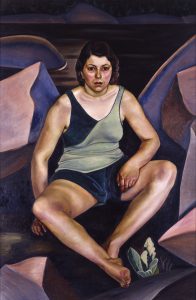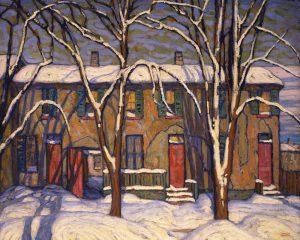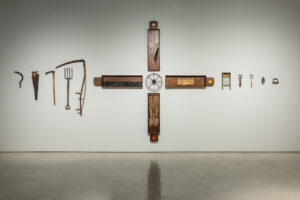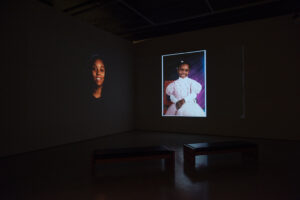- The Group of Seven
- Beaver Hall Hill Group
- The Canadian Group of Painters
In 1920, two groups of artists formed associations dedicated to the furtherance of art in Canada: in Toronto, seven artists presented the first Group of Seven exhibition and, in Montreal, eleven artists formed the Beaver Hall Hill Group. Whereas the artists making up Canada’s renowned Group of Seven were all men, almost all of the Beaver Hall Hill Group artists were women. For the first two exhibitions, the Group of Seven contained its exhibitions to the so-called founding seven (Carmichael, Jackson, Johnston, Harris, Lismer, MacDonald and Varley) but, in 1922, introduced the category “Invited Contributor” and Percy Robinson joined that year’s exhibition. The painter A.H. Robinson joined the 1925 exhibition in this category but no women were included in the “Invited Contributor” category until the Group’s fifth exhibition in 1926. That year, four women showed work in the Group of Seven exhibition as “invited contributors” — Bess Housser, Doris Heustis Mills, Marion Huestis Miller and Anne Savage. Numbers of women exhibiting with the Group of Seven continued to grow throughout the later 1920s but there remains little doubt that inclusion in these exhibitions remained gendered: it was not, for example, until 1930 that the acclaimed painter Emily Carr exhibited with the Seven.
The Beaver Hall Hill Group in Montreal was a very different organization whose cohesion centred on the artist’s sharing of studio space in Beaver Hall Hill in present-day downtown Montreal rather than on exhibiting together as a single aesthetic organization. The gender contrast in its inclusion of women was sharp when compared to the Group of Seven. Women associated with Beaver Hall Hill Group included Nora Collyer, Emily Coonan, Prudence Heward, Mabel Lockerby, Henrietta Mabel May, Kathleen Morris, Lilias Torrence Newton, Sarah Robertson, Anne Savage and Ethel Seath. Neither the Beaver Hall Hill Group nor the Group of Seven would have conceded to the importance of gender within its organizational focus, yet clearly gender did matter.
In fact, gender had become an important consideration during the 1930s when the Group of Seven dissolved its exhibitions to form the Canadian Group of Painters in 1933. The 1934 CGP exhibition in fact included works by ten women, including Carr and Heward, as well as Bess Houser, Mabel May, Yvonne McKague, Isabel McLaughlin, Lilias Newton, Sarah Robertson, and Anne Savage. This larger organization comprised of some 28 artists reflected more accurately the concerns of a diversity of artists and the important contributions made by women to the art scene in Canada which included the striking figurative works of Prudence Heward in this exhibition.
Using the AGW’s collection, this exhibition provides an opportunity to review the importance of gender in organizational membership between the First and Second World Wars in Canada and it provides opportunity for the works of the Group of Seven from the 1920s and early 1930s to be contrasted with their contemporaries. Works by the Group of Seven clearly show the dominant role that painting landscape in oil played in their work whereas those works by affiliates of the Beaver Hall Hill Group show a concern for urban and rural life, the figure and portrait, and the important place of women in art organizations. Later works by artist-members of The Canadian Group of Painters show the introduction of abstraction, as well as concerns for rural life, landscapes of western Canada, as well as a small number of artists who continued to work in the traditions of the Group of Seven.







